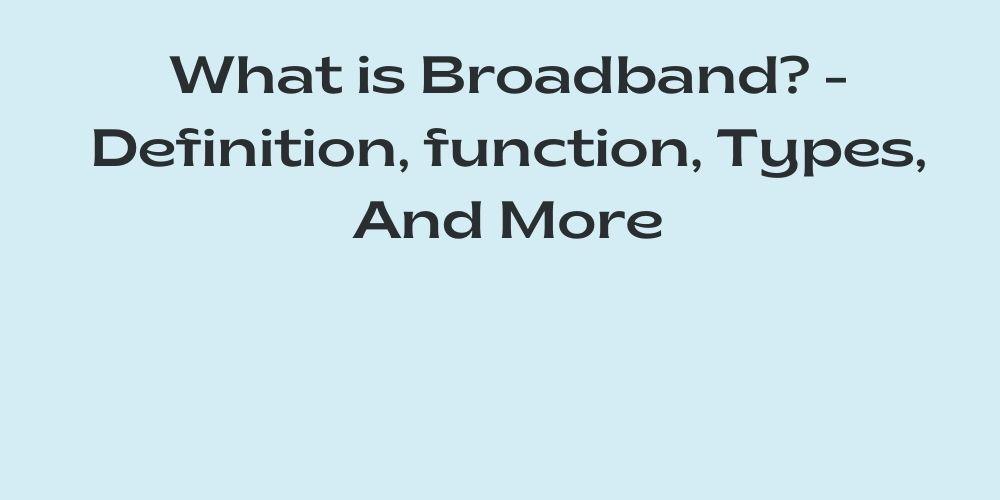Information
What is Broadband Internet?

Broadband internet service is the most widely used form of internet connection due to its various advantages. Dial-up is the only non-broadband internet service that still exists, however, it is now becoming obsolete since the world has moved on to its broadband alternatives.
Broadband internet, which was launched in the 1990s, provides several advantages over traditional dial-up connections in terms of connectivity, speed, cost, and efficiency. Many ISPs such as Windstream internet provide the fastest speed broadband internet connection for homes and offices. Different sectors have greatly improved their work productivity as a result of these internet services.
Continue reading to discover more about broadband internet, its types, features, and some of the finest broadband internet service providers. We’ll answer all of your questions regarding broadband internet in the following sections.
Table of Contents
How is Broadband internet different from Non-broadband Internet?
Broadband and dial-up are two different methods for connecting to the Internet. With the development of the Internet and the parallel development of computers as a viable business and home information management tools, connection to the Internet became a priority, and dial-up was a convenient way to use the existing telephone infrastructure to accomplish it.
Broadband connections operate over a similar infrastructure but end many limitations of the conventional dial-up network. While both dial-up and broadband connections are available to the users, consumers prefer the latter. Following are some basic ways broadband gets an edge over non-broadband internet.
· Connectivity
A dial-up connection transmits digital codes from one computer to another. These digital codes are sent through the phone line, which serves as a link between the two computers and receives digital signals in analog form. When the computer on the other end receives these signals, they must be converted from analog to digital code again. To translate from and to digital code, computers on both ends of the phone connection must be outfitted with special devices known as modems.
A broadband connection, unlike a dial-up connection, employs a dedicated line solely for data transfer. Different types of lines are used by the various broadband connections: A copper phone line for DSL internet, coaxial cable for cable internet, and special fiber-optic connections are needed for fiber internet that provides wireless internet connectivity. Each type of broadband internet connection has its own frequency and speed. An ISP uses a set of equipment including routers, cables, and other devices to set up the required connection.
· Speed
In a dial-up connection, since the computer code is transferred as an analog signal, the speed with which it may be transmitted is limited by the system’s capabilities. In general, the larger the file being transferred, the longer it will take to send. The highest speed achievable with dial-up is 56 kbps and there isn’t much that the dial-up consumers can do to improve the speed of their connection.
On the other hand, there isn’t a defined maximum speed limit that can be achieved by broadband internet. Each type of broadband connection has its speed and there are improvements made every day to increase the threshold even more. According to the Federal Communications Commission (FCC), the minimum download and upload speeds of a broadband internet connection are 25 Mbps and 3 Mbps respectively.
Types of Broadband Internet
There are different types of broadband connections available for different types of users ranging from low to high bandwidths and connection speed.
· DSL
DSL (Digital Subscriber Line) is a technology that transmits data over standard copper telephone lines. The transmission rates of DSL-based broadband range from a few hundred Kbps to millions of bits per second (Mbps). The distance between your house or business and the nearest telephone provider facility may affect the availability and speed of your DSL connection.
· Cable Broadband
Instead of copper wires, cable broadband uses coaxial cables. A copper wire is encircled by a concentric conducting shield and separated by an insulating layer in a coaxial cable. Coaxial cables are a better alternative to standard copper wires because their shielded construction allows the center conductor wire to carry data efficiently while being safe from external interference or damage. Depending on the type of internet subscription, cable broadband speeds range from 20 Mbps to 300Mbps or above.
· Satellite Internet Connection
Satellite internet is a type of wireless internet that is broadcast from orbiting satellites. It is quite different from other types of connection options. Satellite internet is sometimes the only means to get online for many rural households and businesses because it is the only internet service offered countrywide. The connection speed of satellite internet connection can range up to 100 Mbps.
· Fiber Broadband Internet
Fiber internet is many times faster than traditional internet connections, and its speed, bandwidth, and overall quality are rapidly improving. A cable loaded with glass fibers is used to power this sort of internet. These microscopic fibers are superb conductors, allowing them to carry data at fast rates and with the widest bandwidth conceivable. The maximum speed you can achieve with fiber optic internet is around 950 Mbps to 1 Gbps, making it about 20 times faster than the traditional cable connection.
Read more : Why Modern Devices Need Surge Protection? An Overview
What are the Broadband ISPs near Me?
With the advancements being made with the broadband internet connection, many ISPs are providing the service all over the world. In the USA there are some of the best broadband internet providers including those enlisted below you can check their availability in your area by searching with your zip code:
- Windstream Internet
- AT&T Internet
- Spark light Internet
- Comcast High-Speed Internet
- Lumen Technologies
- Charter Communications
- Spectrum Internet
- HughesNet Internet
To summarize
The Internet has become a necessity in today’s digital world. People are not only looking for their gadgets to be connected, but they are also becoming savvier in their connection selection. Broadband internet is a technological innovation that has eliminated the traditional dial-up connection. The elements that distinguish a broadband connection from a non-broadband connection, its sorts, and the major broadband internet service providers are discussed above to help you acquire an astonishingly fast and consistent internet connection today.

-

 Business4 years ago
Business4 years agoHow to Do Long-Distance Moves with Children
-

 Business2 years ago
Business2 years agoThe Ultimate Guide To Thriving In Your Printing Franchise
-

 Business2 years ago
Business2 years agoExploring The Benefits And Challenges Of Restaurant Franchising
-

 Tech4 years ago
Tech4 years agoCyber Table That Will Change Your Life
-

 Business5 years ago
Business5 years agoIs Guest Posting a Good Inbound Marketing Strategy?
-

 Lifestyle2 years ago
Lifestyle2 years agoDallas’ Hidden Gems: 6 Must-Try Restaurants Off The Beaten Path!
-

 Lifestyle3 years ago
Lifestyle3 years agoTop 10 Restaurant Franchises In The US
-

 Business2 years ago
Business2 years agoTop 10 Reasons You Should Invest In A Coworking Franchise













Recent Comments